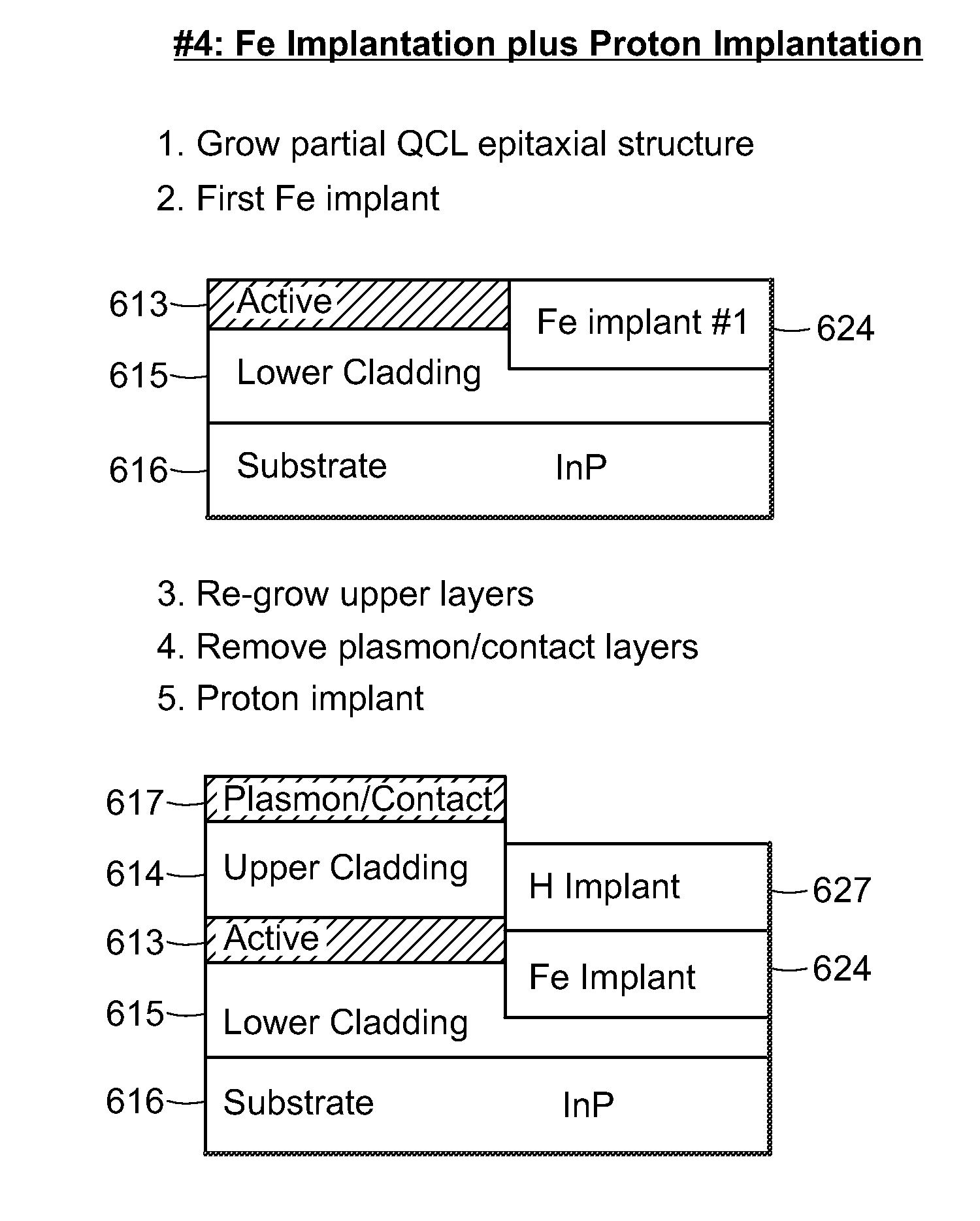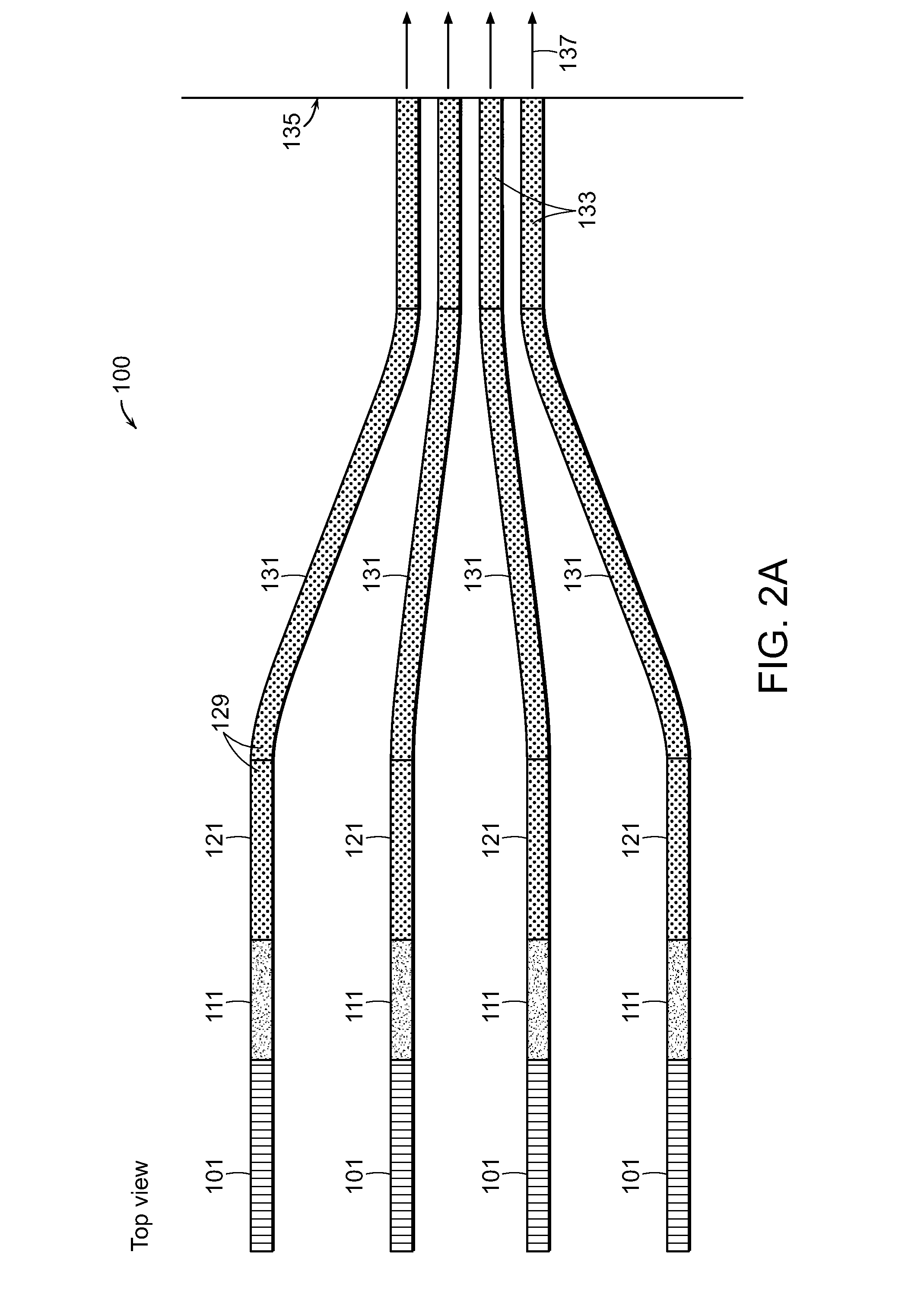Photonic integrated circuits based on quantum cascade structures
- Summary
- Abstract
- Description
- Claims
- Application Information
AI Technical Summary
Benefits of technology
Problems solved by technology
Method used
Image
Examples
example process # 1
Example Process #1: Single-Schedule Proton Implantation
[0095]An example of a processing sequence that involves a single implantation schedule of proton implantation is described. As shown in FIG. 7A, #1, after growth of the completed QC epitaxial structure and after any high-temperature process such as material re-growth to create buried heterostructure devices, the plasmon / contact layer 617 is etched away in the passive portion of the structure, and a schedule of proton implantation is executed in the passive portion of the multi-layer structure intended to become a passive waveguide. In other embodiments, the Plasmon / contact layers are not removed. Since protons can be implanted very deeply, the optical waveguide can substantially be converted to have low loss through the depletion of electronic carriers.
[0096]Alternatively, the implantation schedule can proceed with the plasmon / contact layers intact, but then these layers can be removed during a subsequent etching process. In oth...
example process # 3
Example Process #3: Fe Implantation Plus Fe:InP Re-Growth
[0102]A third example process sequence, shown in FIG. 7C, involves an Fe implantation schedule 624 and subsequent re-growth 626 of Fe:InP upper cladding layers. Example Process #3 is similar to Example Process #2 in that the QC epitaxial material is grown up through the active layer 613, but prior to growing the upper cladding layer 614. In the passive portion of the structure, where the passive waveguide will be fabricated, a first Fe implantation schedule 624 is performed to deposit Fe ions into the active and lower cladding layers 613 and 615, respectively, in the passive portion of the structure. Then the upper cladding 614 for the QC structure is re-grown. In the passive portion of the structure corresponding to passive waveguide, these active and lower cladding layers 613 and 615 are removed and Fe:InP 626 is re-grown to serve as the upper cladding in the passive portion of the structure. Since the plasmon / contact layer ...
example process # 4
Example Process #4: Fe Implantation Plus Proton Implantation
[0104]A fourth example process sequence, shown in FIG. 7D, involves both Fe and proton implantation. Example Process #4 is similar to Example Process #2 in that the QC epitaxial material is grown up through the active layer 613, but implantation is performed prior to completing growth of the upper cladding layer 614. In the passive portion of the structure, where a passive waveguide will be fabricated, a first Fe implantation schedule 624 is performed to deposit Fe ions into the active and lower-cladding layers 613 and 615, respectively. Then the upper layers 614 and 617 are re-grown and the plasmon / contact layer 617 is etched away in the passive portion of the structure. Following the etching, protons are implanted into the upper cladding layer 614 to convert the layer into low-loss material in the passive portion of the structure. In other embodiments, it is desirable to implant protons through the entire waveguiding regi...
PUM
 Login to View More
Login to View More Abstract
Description
Claims
Application Information
 Login to View More
Login to View More - R&D
- Intellectual Property
- Life Sciences
- Materials
- Tech Scout
- Unparalleled Data Quality
- Higher Quality Content
- 60% Fewer Hallucinations
Browse by: Latest US Patents, China's latest patents, Technical Efficacy Thesaurus, Application Domain, Technology Topic, Popular Technical Reports.
© 2025 PatSnap. All rights reserved.Legal|Privacy policy|Modern Slavery Act Transparency Statement|Sitemap|About US| Contact US: help@patsnap.com



